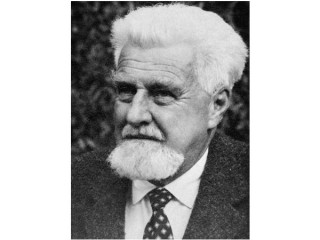
Konrad Z. Lorenz biography
Date of birth : 1903-11-07
Date of death : 1989-02-27
Birthplace : Altenberg, Austria
Nationality : Austrian
Category : Science and Technology
Last modified : 2011-10-11
Credited as : Nobel Prize for Physiology, Behind the Mirror or The Other Side of the Mirror, physiology of animal behavior
The animal psychologist Konrad Z. Lorenz (1903-1989) did much work in the field of the physiology of animal behavior and on the development of social relationships, particularly imprinting. He also explored the relationship between animal behavior and human sociology.
Konrad Z. Lorenz was born on November 7, 1903, in Altenberg, Austria. His father was already a world-renowned surgeon, having created a hip-joint operation procedure. Young Lorenz studied medicine at Columbia University and at the University of Vienna. In addition to his medical degree, he obtained the Ph.D. in zoology at the University of Vienna where in 1937 he was appointed lecturer in comparative anatomy and animal psychology. In 1940 he was appointed professor of comparative psychology and head of the department at the University of Konigsberg; however, in 1943 he was drafted into the German army as a psychiatrist. He was taken prisoner of war by the Russians in 1944 and released in 1948. Shortly thereafter he became head of the Research Station for the Physiology of Behavior at the Max Planck Institute for Marine Biology. In 1956 he became co-director, along with ethologist Gustav Kramer and physiologist Erich von Helst, of the Max Planck Institute for Behavioral Physiology in Seeweisen, Bavaria, a position he retained until his retirement in 1973. It was also in 1973 that, along with two other zoologists, Nikolaas Tinbergen and Karl von Frisch, he was awarded the Nobel Prize for Physiology or Medicine, the first time any individual in the behavioral sciences had been so honored. From 1973 to 1982, Lorenz served as director of the Department of Animal Sociology, Institute of Comparative Ethology, Austrian Academy of Science. He was later director of the Ethological Research Station at the Konrad Lorenz Institute of the Austrian Academy of Sciences.
Lorenz's contributions to the study of animal behavior were immense, but his work on the development of social relationships, especially the phenomenon of imprinting, deserves special note. In his research Lorenz emphasized the importance of the direct observation of animal behavior under natural conditions. One of the theoretical strengths of Lorenz's work was his attempt to combine evolutionary and causal explanations of behavior. The fledgling science of ethology was founded in the early 1930s by Oscar Heinroth, director of the Berlin aquarium, with whom Lorenz
had a long-standing friendship. That relationship profoundly affected Lorenz's view of the science of studying behavior. One of Lorenz's earliest contributions was the introduction of the concept of angeborener Auslösemechanismus ("innate releasing mechanism" or IRM). Also, in 1935 Lorenz coined the term Prägung, or "imprinting, " to denote the rapid process of learning during the sensitive period in early development.
Lorenz's best-known book among social scientists, On Aggression (1966), prompted considerable discussion because of his contention that for animals intragroup aggression might have beneficial consequences. Prior to the publication of On Aggression, however, Lorenz had published three other books: King Solomon's Ring (1952), a charming introduction to the evolution of behavior; Man Meets Dog (1954); and what Lorenz himself considered his most important contribution, The Evolution and Modification of Behavior (1965), a reply to Donald Lehrman's 1953 critique of his work published in the Quarterly Review of Biology. In 1970 and 1971, Harvard University Press published a two-volume compendium of Lorenz's papers, most of which were originally published in German, entitled Studies in Animal and Human Behavior. The volumes brought together in one place much of Lorenz's thinking on studies of genetically-determined patterns of behavior to describe evolutionary sequences and relationships among species.
However, there was another side of Konrad Lorenz which showed a psychologist of great breadth who was interested in learning theory, social psychology, psychology of science, and the political implications of evolutionary genetics. In 1973 he published Civilized Man's Eight Deadly Sins, in which he explained in dramatic didactic tones that humans' capacity for genocide is based on social devices that separate cultures and make individuals from different cultures seem nonhuman. His next book, Die Rückseite des Spiegels (translated as Behind the Mirror or The Other Side of the Mirror), published in 1977, makes a valuable contribution to a basic problem in the philosophy of psychology—namely, the question of conscious experience in other animals and the mind-body relationship. A later book, The Year of the Greylag Goose (1979), is a return to some of his original concerns in the study of animal behavior.
In addition to the Nobel Prize, Lorenz received numerous professional honors. He held eight honorary degrees from universities in Europe and North America. He received the Gold Medal from the New York Zoological Society and the Austrian Award for Distinction in Science and Art, as well as many other awards and prizes. Konrad Lorenz did most of his post-retirement work from his childhood home in Altenberg, Austria. Lorenz died February 27, 1989, of kidney failure at his home. He was 85 years old.
The major intellectual positions and views on science and human nature of Konrad Lorenz are traced in Konrad Lorenz: The Man and His Ideas (1975) by Richard I. Evans. A critical review of some of Lorenz's work is found in Lehrman's "A critique of Konrad Lorenz's theory of imitative behavior, " published in the Quarterly Review of Biology (1953). Other reviews of Lorenz and his work are found in the November 1974 issue of Psychology Today and in Science 182 (1973). □
















